Kwangjin 굉진 Commemorative Medal
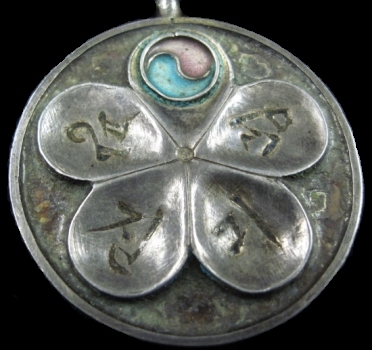
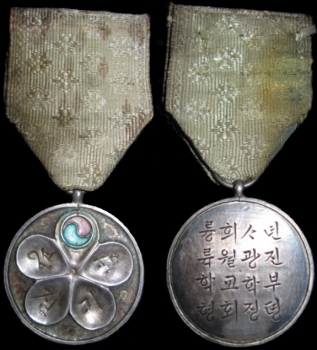
From the G. Notarpole Collection
The Obverse.
The overall obverse design is a plum flower 이화 (李花). It is the original family emblem of the Yi Dynasty’s Royal Family and was derived from their name. It is one of the standard symbols used during the Korean Empire Period. The Taeguk at the top has red superior to the blue, which is correct, but the whorls are going in a clockwise direction. This is the opposite of how they are rendered today, but the clockwise direction was the standard way that it was used during the Empire Period. A brief look at the Order of Taeguk will confirm this.
The text is a stylized, almost cursive script, which reads as: 광진긔념. The first two characters, 광진 Kwangjin, is the name of a school (more on this below). The two characters 긔념 is an old form of 기념 meaning “Commemoration” and is similar to 기념장 Commemorative Medal. So, the obverse text reads 광진긔념 Kwangjin Commemorative.
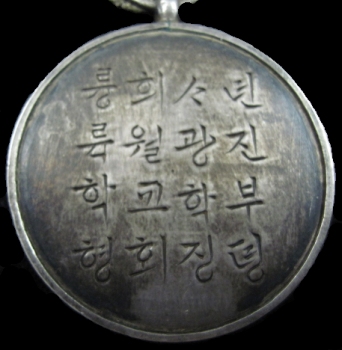
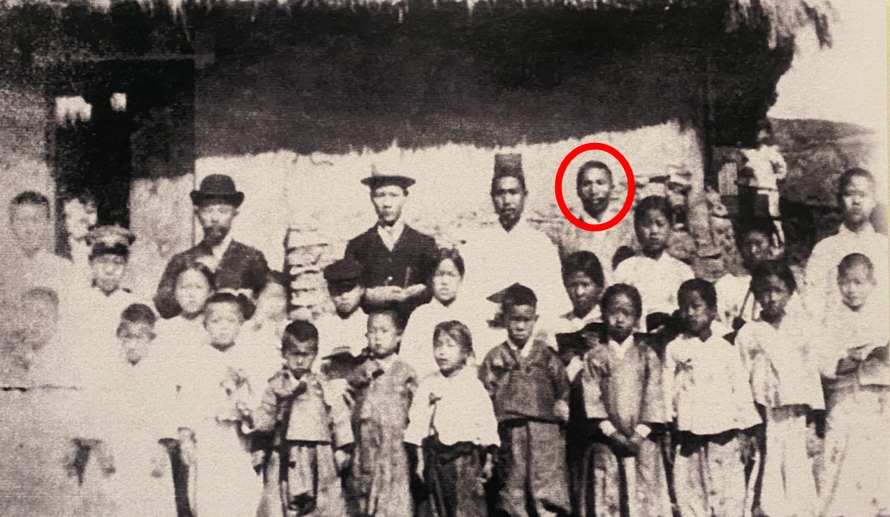
Image source: Baekbeom Kim Ku Memorial Hall
The Reverse
The reverse is also written in an informal cursive style. The complete text is 륭희ᄉᆞ년륙월광진학교학부형회징뎡, and the translation will take a bit of effort to explain. The first two characters are 륭희, which is an archaic way of writing Yung Hui 융희 (隆熙). Yung Hui was the era name for Sunjong 순종 (純宗), the last Emperor of Korea who reigned from 1907 to 1910. The next two words in the text are ᄉᆞ년. The period at the bottom of the first word is an archaic vowel in “Old Hanʼgŭl” that is no longer used, but a modern rendering for ᄉᆞ would be 사 meaning 4.1 This is followed by the word 년 meaning year. The next two terms are 륙월. The word 륙 is an old way of saying 6 and is still being used today in North Korea.2 This is followed by 월 meaning month. So, the first six words “륭희ᄉᆞ년륙월” translates as “(Emperor) Yung Hui 4th year, 6th month” which is June 1910. The next two words are 광진, which is the same school name that is on the obverse (more on this below). The last eight characters 학교학부형회징뎡 translate as School Faculty Association. The entire reverse inscription 륭희ᄉᆞ년륙월광진학교학부형회징뎡 translates as, “(Emperor) Yung Hui, 4th year, 6th month Kwangjin School Faculty Association”, or more succinctly “June 1910 Kwangjin School Faculty Association”.
I have found several listings for the 광진학교 Kwangjin School, but most of the listings are for schools established after 1944. There is one school, found in a brief mention of Jeong Heon-tae 정헌태 (鄭憲台, 1902~1940)3 which states that he was a teacher at Kwangjin School in Kaesong 개성 in present day North Korea.4 However, I have not found a second source to confirm that the school even existed in Kaesong. By far, the most plausible location was Kwangjin School 광진학교 (光進學校) in Jangryeon 장련, Eunyul-gun 은율군(殷栗郡), South Hwanghae Province 황해남도, present day North Korea. I found multiple listings for this school because of its ties to Kim Ku 김구 (金九 1876~1949) and the Korean Independence Movement. I cannot stress enough how important Kim Ku is to 20th century Korean history. The Kwangjin School was, originally, a private school, established in Oh In-hyeon’s 오인형 sarangbang 사랑방 (舍廊房), to educate his children.5 With government approval, this school evolved into the Kwangjin School and on September 1, 1905, it was formally established by the “General Assembly of the Presbyterian Church of Jesus Christ”조선예수교장로교 총회 in Jangryeon 장련. The origin of the General Assembly dates back to 1898 when the Rev. Horace G. Underwood (1859-1916), a doctor and the first Presbyterian missionary in Korea, arrived in South Hwanghae Province 황해남도.6 Kim Ku served as an Assistant Teacher at Kwangjin School. At right there is a picture of him, along with other staff members and students, which dates to the summer of 1906. As far as I can determine, Kwangjin School had its first graduation class in 1910 and the graduates may have received this medal at that time.7 Even though the school was run by a religious organization, the school building is still being maintained today in North Korea because of its ties to the Korean Independence Movement. This medal just drips with history.
Piecing this puzzle together would not have been possible without the generous assistance of a several people. I wish to thank: Kim Chu, Librarian / Garden Grove (CA) Main Library, Zoë Yun, Librarian III / Branch Manager / Fountain Valley/OC Community Resources (CA), and any other people who helped in this endeavor.
Korean Women’s Association Medal 大韓婦人會章 (대한부인회장)
At the end of the 19th century, Chosŏn society encountered imperialist powers and Western modernity, which forced the contradictions of Korea’s feudal system into the limelight.
During this period, a new view of women was emerging and a modern women’s movement began to take place. Printed material during those early years reveals that there were around thirty women’s organizations in the Seoul area alone.8 Many of these organizations were active, pro-Japanese women’s groups, but many were also interested in social reforms, including the establishment of schools for the education of women. Many of the women who participated in these organizations were the wives of upper echelon, high-ranking officials, with approx. 30 – 40 of them being members of the Korean nobility. Queen Empress 皇貴妃 Eombi was a pioneer in education for Korean women and actively accepted Western culture. She established three schools for women using her money: Yang Jeongsuk (today Yangchung High School 양정고등학교 養正高等學校) in 1905, and Jinmyeong Girls’ School (today Jinmyeong Girls’ High School 진명여자고등학교 進明女子高等學校) in Apr. 1906 and Myeongshin Girls’ School (today Sookmyeong Women’s University 숙명여자대학교 淑明女子大學校) in May 1906.9
In 1905, as social gatherings between Korean and Japanese women became more active, the wife of an official at the Japanese Embassy in Korea suggested organizing a women’s association. Consequently, Lee Ok-gyeong 이옥경 formed the Korean Women’s Association 대한부인회 in July 1905. She was elected president and went on to recruit numerous wives of high-ranking officials, both Korean and Japanese. A number of the Japanese wives, who had husbands in the Korean Residency-General 統監府, were appointed as executives of the association. The association’s goal was to encourage women’s vocational education. The organization was established with the active support of King Kojong and the imperial family, and its main activity was the operation of a dormitory training center.10
During early spring, the reigning queen of Chosŏn performed the Chinjamrye 친잠례 (親蠶禮) rituals. It was a series of ceremonies in which the Queen personally cultivated silkworms and collected the cocoons (sericulture 양잠 養蠶). It was meant to symbolize meaningful women’s labor. While men went to the fields to farm and produce food, women stayed in the home and produced cloth. Silk was a representation of the fabric produced by women. Just before the ceremony, the queen offered sacrifices at the Seonjam Altar 선잠단 (先蠶壇) to Nujo 누조 (嫘祖). She was the wife of the legendary Chinese Emperor Heonwon (黃帝軒轅氏) who discovered and was the founder of sericulture.
In July 1904, the Ministry of Palace Affairs was revised, and a Weaving Department was established. Its purpose was to oversee sericulture, silkworm farming, ancestral rites, and weaving. Because of the importance of silk to the Korean nobility, the Korean Women’s Association set up and operated the Silk Training Center office 대한부인회잠업강습소. They were granted the Sericulture Experiment Station in Yongsan, which had belonged to the Chosŏn Imperial Household Office (宮內府). The Training Center was established with the active support and subsidies of the imperial family. Initially, the Training Center had few female applicants and started by accepting males. From September 1, 1906, until Oct. 1909, it produced a total of 92 graduates, of which 57 were male and 40 were female. They exhibited sericulture-related products at the 1907 Gyeongseong (Seoul) Exposition, 京城博覽會. In February 1910, with the annexation of Korea, the training school was returned to the Ministry of Agriculture, Commerce, and Industry and converted into a government operated women’s sericulture training center. It was placed under the Yongsan branch of the Industrial Promotion Model Station. The Korean Women’s Association Training Office was abolished. I have been unable to find any information on this association after 1910.
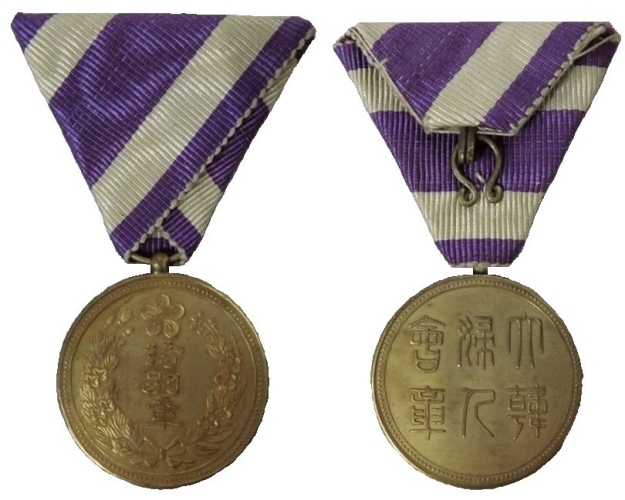
Obverse: 特別 章 (특별 장) Special Medal
Reverse: 大韓婦人會章 (대한부인회장) Great Han (Korea) Women’s Association
Photo courtesy of Medals of Asia
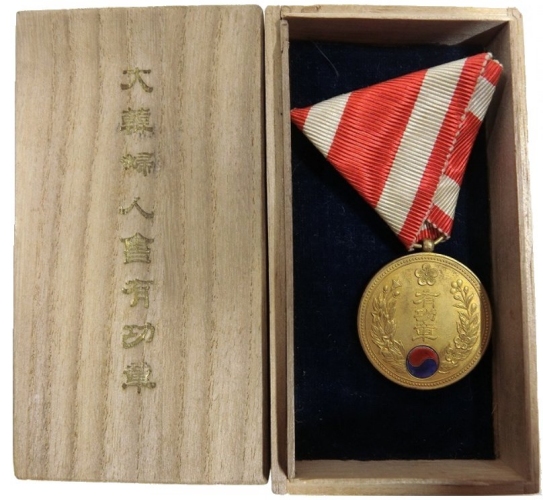
“Korean Women’s Association Medal of Merit”
The inscriptions on both of these medals are identical. The obverse has : 特別 章 (특별 장) Merit Medal or Special Medal, while the reverse has: 大韓婦人會章 (대한부인회장) Great Han (Korea) Women’s Association. Both medals use the phrase 大韓 “Great Han” (Great Korea) which is a shortened term referencing the Great Han Nation 大韓國 (대한국) or Great Han Empire 大韓帝國 (대한제국). Medals issued later during the colonial period generally use the term 조선 (朝鮮) Chosŏn, which was the name used by the Japanese for Korea. At the top of both obverses is a plum blossom/flower, which is the symbol of the Korean Royal Family and by extension, the Korean Imperial Dynasty.
The medal with the purple and white trifold ribbon was sold in a Japanese auction on July 7, 2021, for ¥34,100 including tax {approx. $230 U.S.}. For more pictures of this Korean medal, you can still go to the original auction listing. The other medal with the red and white trifold ribbon was also sold in a Japanese auction on Jan. 10, 2023 for ¥44,594 including tax {approx. $300 U.S.}. You can still go to the original auction listing. I found this same picture on a Korean website, which gives the dimensions as 4.1×7.2, 5.3×8.5 cm. It also referred to it as the Gold Medal, but I am uncertain if that is the material used or the classification. These images, and other pictures and information on Asian Medals, can be found at the: Medals of Asia website.
Footnotes:
- Click here for the Etymology of ᄉᆞ
- Click here for the Wiktionary entry for 륙
- Click here for a quick biography of Jeong Heon-tae.
- In 2005, newspaper articles stated that, although Jeong Heon-tae was an avowed Communist/Socialist, he would be awarded the South Korean Order of National Foundation 건국훈장, Independence 독립장 (獨立章) Class.
- A sarangbang is a sort of formal den, used by the family patriarch in a traditional Korean home
- If the name Underwood sounds familiar, it’s because, his older brother, John T. Underwood, established a typewriter company in New York. He funded much of his younger brother’s missionary work.
- For an exhaustive study of Kim Ku and the Kwangjin School, see “1900년대 김구의 황해도 장련·문화·안악 이주와 계몽운동”
- The Women’s Education Association 여자교육회, Jinmyeong Women’s Association 진명부인회 進明夫人會, Yangjeong Women’s Education Association 양정여자교육회 楊定女子敎育會, Korean Women’s Society 大韓女子興學會, Korean-Japanese Women’s Association 한일부인회, Women’s Charity Association 자선부인회, Oriental Patriotic Women’s Association 동양애국부인회, Jahye Women’s Association 자혜부인회, Korean-Japanese Women’s Association 한일부인회, and the Daean-dong National Debt Women’s Association 대안동국채보상부인회.
- Eom Seon-yeong (엄선영, 嚴善英 1854 – 1911, Consort Sunheon, Lady Eom 순헌황귀비 엄씨) was a consort of the Korean King and Emperor Kojong. She was the mother of Yi Un 이은 the last Crown Prince of the Korean Empire.
- Lee Ok-gyeong was the wife of Lee Ji-yong 이지용 (李址鎔1870 – 1928 ), one of the five Eulsa traitors 을사오적 (乙巳五賊). Among the upper echelon women in Korea, she held a dominant position in pro-Japanese activities. Purportedly, she also had a very sordid personal life, although this could be a result of revisionist history.
